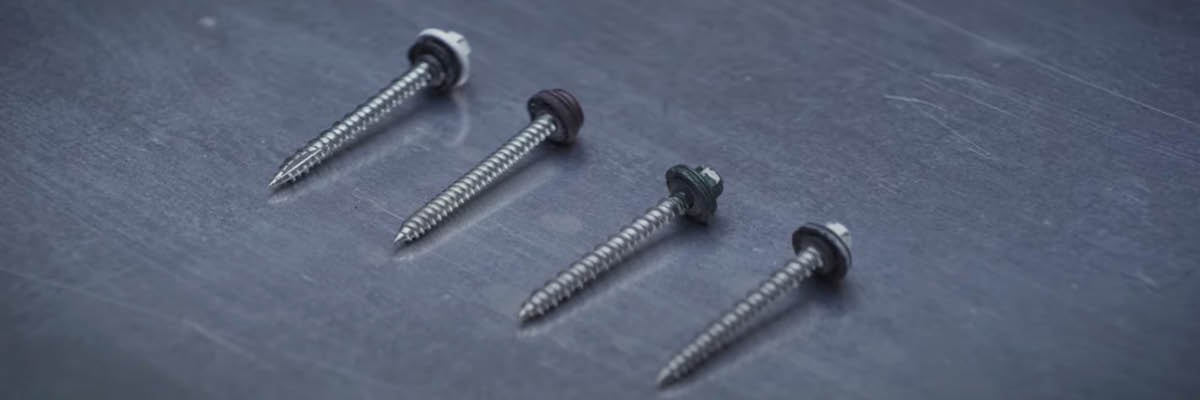Posts | Videos | Structural Integrity | Comparisons | Product Review
Comparing Pole Barn Screws: Cleary, Morton, Menards & FBi Buildings
Cori grew up on her family's small grain and livestock operation in Northwest Indiana. In 2018, she graduated Summa Cum Laude with a Bachelor's degree in Business Administration & Marketing from Marian University Indianapolis. Having shown beef cattle for 12 years at the county, state, and national levels, Cori chose to pursue a career in agriculture. Today, she serves as the Marketing Content Creator on the FBi team. In her free time, Cori enjoys spending time with family and friends, watching sports, listening to live music, and traveling.
Every post-frame builder wants you to purchase their product over the competition. It’s the nature of business.
Their pole barns are superior in terms of structural integrity. They use higher-quality building materials that withstand the test of time.
Their warranty covers more components for longer periods. Their construction crews are more efficient.
You get the gist. As consumers, we hear these claims all the time. But, how do you know if their post-frame buildings are the best on the market? Do they have concrete evidence to back up such a bold statement?
Hearing the same sales pitch from post-frame builders is not only annoying but makes you wonder who is telling the truth. To settle this debate, we conducted a series of tests to determine which pole barn claims are fact or fiction.
This article discusses the performance of screws used by Cleary Buildings, FBi Buildings, Morton Buildings, and Menards. Let’s find out which post-frame builder has the strongest fastener, shall we?
Editor’s Note: If you don’t have time to read this blog in its entirety, you can watch the video below to see which screw is the most durable.
How Do Fasteners Affect Pole Barn Structural Integrity?
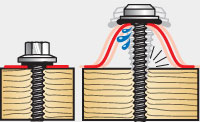 First, the fastener is a restraint that holds something in place. The term “fastening system” refers to the type of fastener used and how/where it’s applied. In post-frame construction, fasteners attach wood to wood and steel to wood.
First, the fastener is a restraint that holds something in place. The term “fastening system” refers to the type of fastener used and how/where it’s applied. In post-frame construction, fasteners attach wood to wood and steel to wood.
A pole barn gets its strength from the “diaphragm” created by the steel siding and metal roofing – the tighter the connection, the better the structural integrity.
When comparing post-frame builders, you must pay close attention to which fastening system they use. We recommend using screws over nails. The former has superior holding power compared to the latter (700 pounds versus 250 pounds).
Moreover, wood fibers tend to return to their original position when a nail or screw is driven inside. Nails push the wood fibers downward, while screws pull the wood fibers upward. As the wood fibers return to their original position, they push the nails out and pull the screws closer.
Post-frame builders have two choices when installing fasteners: the top of the rib or the flat area in-between the ribs. Making a connection in the flat area is a more secure construction method.
Furthermore, a firm grip maximizes seal effectiveness and strength. A fastener that encapsulates the rubber washer prevents leaks and subsequent rust.
Comparing Pole Barn Screws: 4 Tests to Determine Strength
Now that you understand the importance of pole barn screws, we can discuss the results from the following tests we conducted in our Research & Development lab: visuals, pull, shear, and strength.
Editor’s Note: We purchased the 2-inch screws directly from Cleary, FBi, Morton, and Menards. Please contact our office for proof of purchase (if needed for peace of mind).
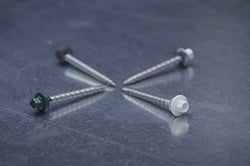
1) Pole Barn Screw Visual Test
Objective: A visual analysis of the pole barn screws.
First, we compared the fasteners in terms of composition and dimension (e.g., length, width, and thickness).
Cleary and Menards were very similar in appearance. Both screws are self-tapping, meaning that they tap their own holes as they’re drilled into building materials. They measured 10.2 millimeters wide and 0.1 millimeters thick. Also, the washers are disconnected from the screw head.
Contrarily, the head of Morton’s fastener is rounder. It measured 10.1 millimeters wide and 0.2 millimeters thick. Their pole barn screws are not self-tapping, meaning a drill bit should be used to create a pilot hole for easier installation.
FBi Buildings’ screw is self-tapping and measures 10.3 millimeters wide and 0.4 millimeters thick. The head of the fastener encapsulates the rubber washer, which is noticeably thicker than the other brands.
|
Measurement |
Cleary Buildings |
FBi Buildings |
Morton Buildings |
Menards |
|
Thickness (mm) |
0.1 |
0.4 |
0.2 |
0.1 |
|
Width (mm) |
10.2 |
10.3 |
10.1 |
10.2 |
|
Composition |
Non-stainless |
Non-stainless |
Stainless |
Non-stainless |
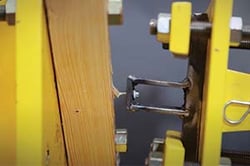
2) Pole Barn Screw Pull Test
Objective: To determine how the threading affects how much force is needed to pull the pole barn screw out of the wooden plank.
Second, we screwed the fasteners down to a piece of lumber and mechanically pulled them out (measured in pounds). The placings were based on an average of data collected in three tests.
FBi placed first, followed by Morton, Menards, and Cleary. Please see the chart below for the pounds needed to pull each pole barn screw out of the wooden plank.
The differences are minute, but coarse threads generally have a greater grip on the building material.
|
Measurement |
Cleary Buildings |
FBi Buildings |
Morton Buildings |
Menards |
|
Pounds (lbs) |
1,203 |
1,508 |
1,390 |
1,304 |
 3) Pole Barn Screw Shear Test
3) Pole Barn Screw Shear Test
Objective: To determine how much force the pole barn screw can handle before it shears off the metal paneling and wood framing.
Third, we conducted a test to see how much weight it would take before the fastener bends or breaks. Again, the placings were based on an average of data collected in three tests.
FBi placed first, followed by Cleary, Menards, and Morton. Please see the chart below for the pounds needed to shear each pole barn screw off the intended building material.
Morton is the only post-frame builder to use a stainless steel fastener in this experiment. “Due to its low carbon content, stainless steel is somewhat softer than carbon steel. It’s more vulnerable to denting and bending.” (Source: Polycase)
|
Measurement |
Cleary Buildings |
FBi Buildings |
Morton Buildings |
Menards |
|
Pounds (lbs) |
2,179 |
2,648 |
1,527 |
2,104 |
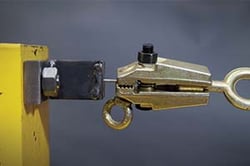 4) Pole Barn Screw Strength Test
4) Pole Barn Screw Strength Test
Objective: To determine how much force is needed to pull the pole barn screw apart (from head to tip).
Lastly, we applied significant pressure from one end of the fastener to the other to see how much weight it could handle before it snapped in half.
FBi placed first, followed by Morton, Cleary, and Menards. Please see the chart below for the pounds needed to pull the screw apart. As mentioned above, the placings were based on an average of data collected in three tests.
|
Measurement |
Cleary Buildings |
FBi Buildings |
Morton Buildings |
Menards |
|
Pounds (lbs) |
1,087 |
1,705 |
1,273 |
1,049 |
Which Pole Barn Screw Came Out on Top?
In conclusion, we discovered that FBi and Morton use durable fasteners when compared to Cleary and Menards. The test results prove that these post-frame builders use high-quality building materials.
It’s no surprise that the former options are more expensive than the latter ones, but you’ll save money in the long run when you don’t have to worry about extensive building repairs.
|
Type of Test |
Cleary Buildings |
FBi Buildings |
Morton Buildings |
Menards |
|
Visual |
– |
– |
– |
– |
|
Pull |
4th place |
1st place |
2nd place |
3rd place |
|
Shear |
2nd place |
1st place |
4th place |
3rd place |
|
Strength |
3rd place |
1st place |
2nd place |
4th place |
Now, you’re probably thinking, “Shouldn’t a third-party test these pole barn screws? It’s hard to believe the post-frame builder trying to sell their product.”
We understand your hesitation, but this experiment isn’t our first time comparing our competitor’s building materials. In fact, they’ve outperformed us in some categories, and vice versa. A perfect example is our Pole Barn Steel Comparison Test.
Conducting honest comparisons and product reviews is important to us and the marketplace to ensure we’re improving post-frame construction.
Which Type of Pole Barn Screw Will You Choose?
Fasteners are one component of pole barn structural integrity; therefore, it’s important to consider the following factors when designing your post-frame building:
- Foundation
- Trusses
- Truss-to-column connection
- Roof purlins and sidewall girts
- Steel panels and paint system
- Proper construction practices
It only takes one weak link to jeopardize the load path, so we highly recommend researching pole barn builders and their products. These insights will allow you to build with confidence.
Do you have more questions about pole barn screws that aren’t covered in this article? If you need help designing and planning, please contact FBi Buildings at 800.552.2981 or click here to email us. If you’re ready to get a price, click here to request a quote, and a member of our sales team will determine the next steps of your project.
